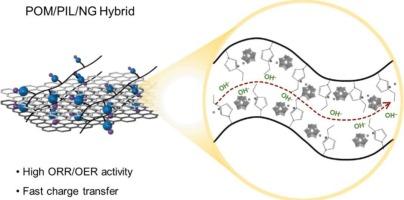聚合物离子液体用于柔性锌空气电池的分子分散多金属氧酸盐团簇
IF 13.2
1区 工程技术
Q1 ENGINEERING, CHEMICAL
引用次数: 0
摘要
聚金属氧酸盐(POM)具有很强的Brønsted酸性,是一种很有前途的催化剂;然而,由于配体体积大且绝缘,其电导率低,在载体上分散不均匀,限制了其作为电催化剂的应用。在这里,我们展示了分子分散的多金属氧酸盐团簇通过聚合物离子液体(PIL)连接剂支撑在氮掺杂的还原性氧化石墨烯(NG)上,形成用于柔性锌空气电池(ZABs)的POM/PIL/NG。通过氧化还原活性金属(Co)的化学修饰,扩大了氧化还原活性表面积,加快了氧的传输速度,实现了氧还原反应(ORR)和析氧反应(OER)的双功能和高电催化活性。此外,PIL改善了POM和NG之间的界面稳定性和离子转移。因此,POM /公益诉讼/ NG混合electrocatalysts取得优秀的催化活动,包括一个高发病和半波的潜力奥尔(Eon = 0.84 V, E1/2 = 0.79 V)和低OER过电压(η10 = 430 mV)。因此,含有POM/PIL/NG的可充电ZABs具有1007 mW cm−2的高功率密度和超过340 次循环的稳定电压分布。此外,准固态ZABs证实了其作为柔性储能器件的潜力,其功率密度为45.0 mW cm - 2,可为串联电池配置的各种电子设备供电。本文章由计算机程序翻译,如有差异,请以英文原文为准。

Molecularly dispersed polyoxometalate clusters via polymeric ionic liquid for flexible zinc–air batteries
Polyoxometalate (POM) exhibits strong Brønsted acidity, making it a promising catalyst; however, its application as an electrocatalyst is limited by a low electrical conductivity and non-uniform dispersion on the support due to bulky and insulating ligands. Here, we demonstrate molecularly dispersed polyoxometalate clusters supported on nitrogen-doped reduced graphene oxide (NG) via a polymeric ionic liquid (PIL) linker forming POM/PIL/NG for flexible zinc–air batteries (ZABs). The molecularly dispersed POM clusters achieved bifunctional and high electrocatalytic activity of oxygen reduction reaction (ORR) and oxygen evolution reaction (OER) through a chemical modification with redox-active metal (Co), and enlarged redox-active surface area, and fast oxygen transport. Additionally, PIL improved the interfacial stability and ion transfer between POM and NG. Thus, POM/PIL/NG hybrid electrocatalysts achieved the outstanding catalytic activities, including a high onset and half-wave potential of ORR (Eon = 0.84 V, E1/2 = 0.79 V) and a low OER overpotential (η10 = 430 mV). Consequently, rechargeable ZABs with POM/PIL/NG delivered a high power density of 100.7 mW cm−2 with stable voltage profiles over 340 cycles. Furthermore, quasi solid-state ZABs confirmed the potential as flexible energy storage devices, delivering a power density of 45.0 mW cm−2 and powering various electronic devices in tandem cell configurations.
求助全文
通过发布文献求助,成功后即可免费获取论文全文。
去求助
来源期刊

Chemical Engineering Journal
工程技术-工程:化工
CiteScore
21.70
自引率
9.30%
发文量
6781
审稿时长
2.4 months
期刊介绍:
The Chemical Engineering Journal is an international research journal that invites contributions of original and novel fundamental research. It aims to provide an international platform for presenting original fundamental research, interpretative reviews, and discussions on new developments in chemical engineering. The journal welcomes papers that describe novel theory and its practical application, as well as those that demonstrate the transfer of techniques from other disciplines. It also welcomes reports on carefully conducted experimental work that is soundly interpreted. The main focus of the journal is on original and rigorous research results that have broad significance. The Catalysis section within the Chemical Engineering Journal focuses specifically on Experimental and Theoretical studies in the fields of heterogeneous catalysis, molecular catalysis, and biocatalysis. These studies have industrial impact on various sectors such as chemicals, energy, materials, foods, healthcare, and environmental protection.
 求助内容:
求助内容: 应助结果提醒方式:
应助结果提醒方式:


